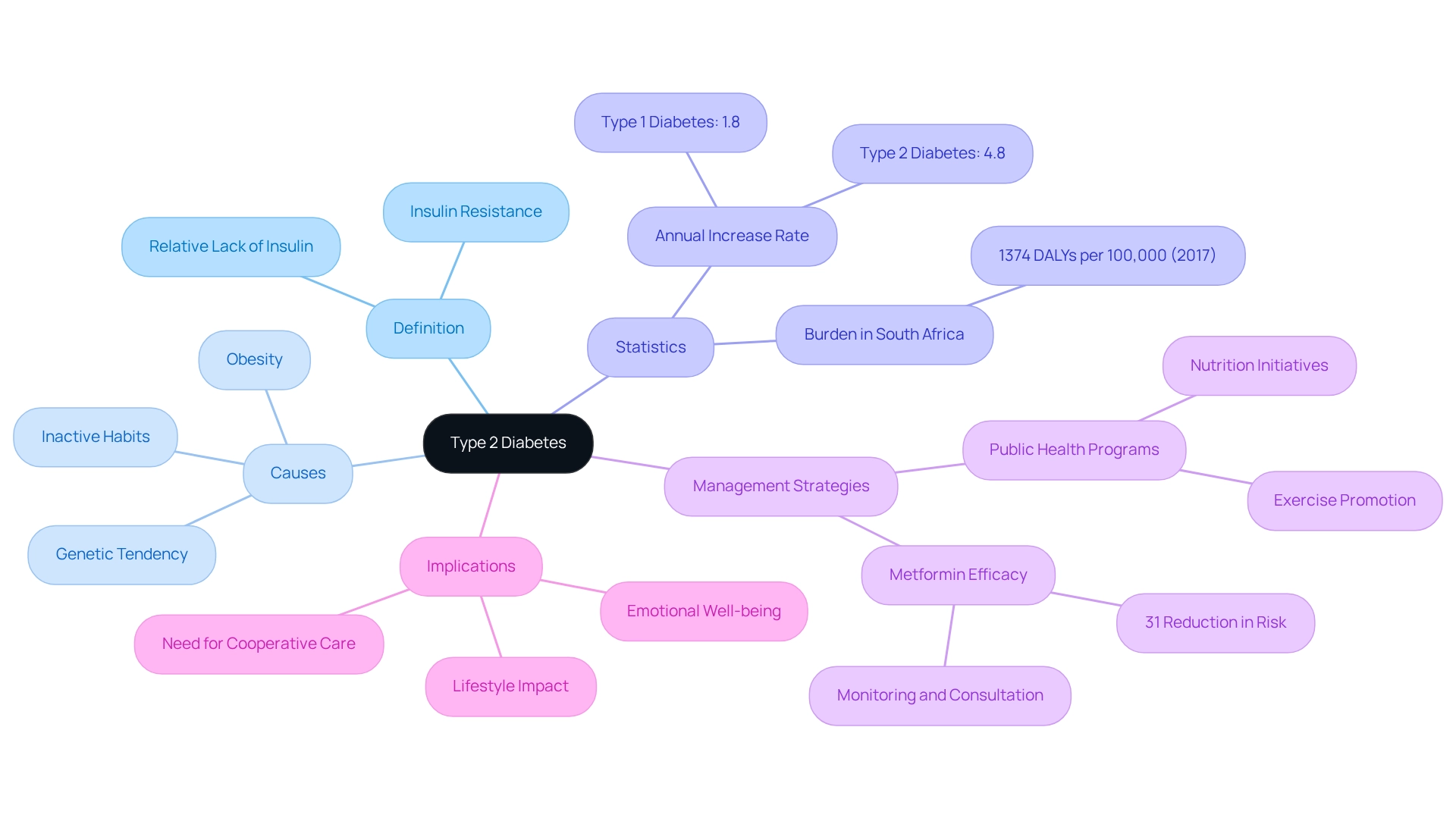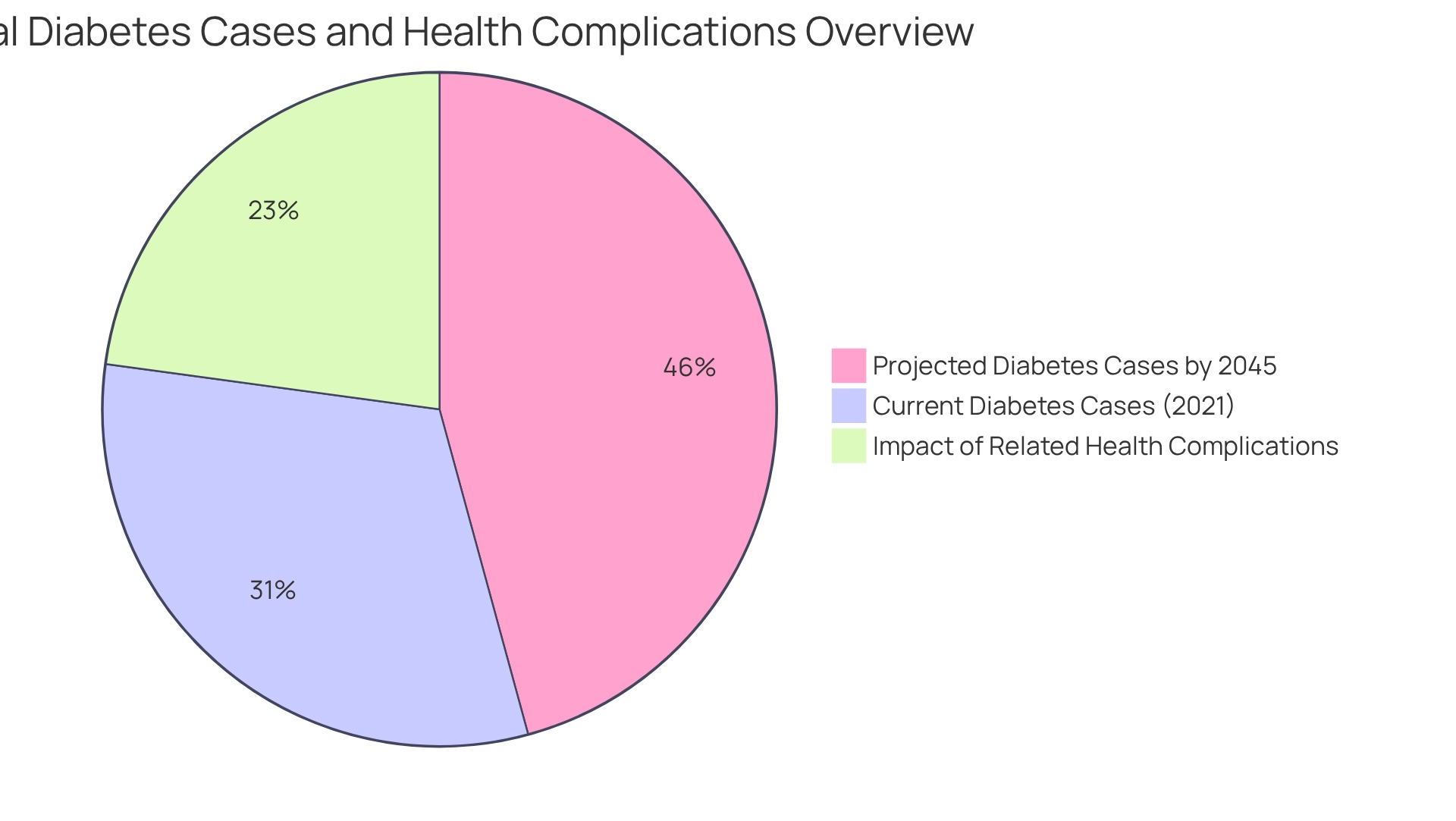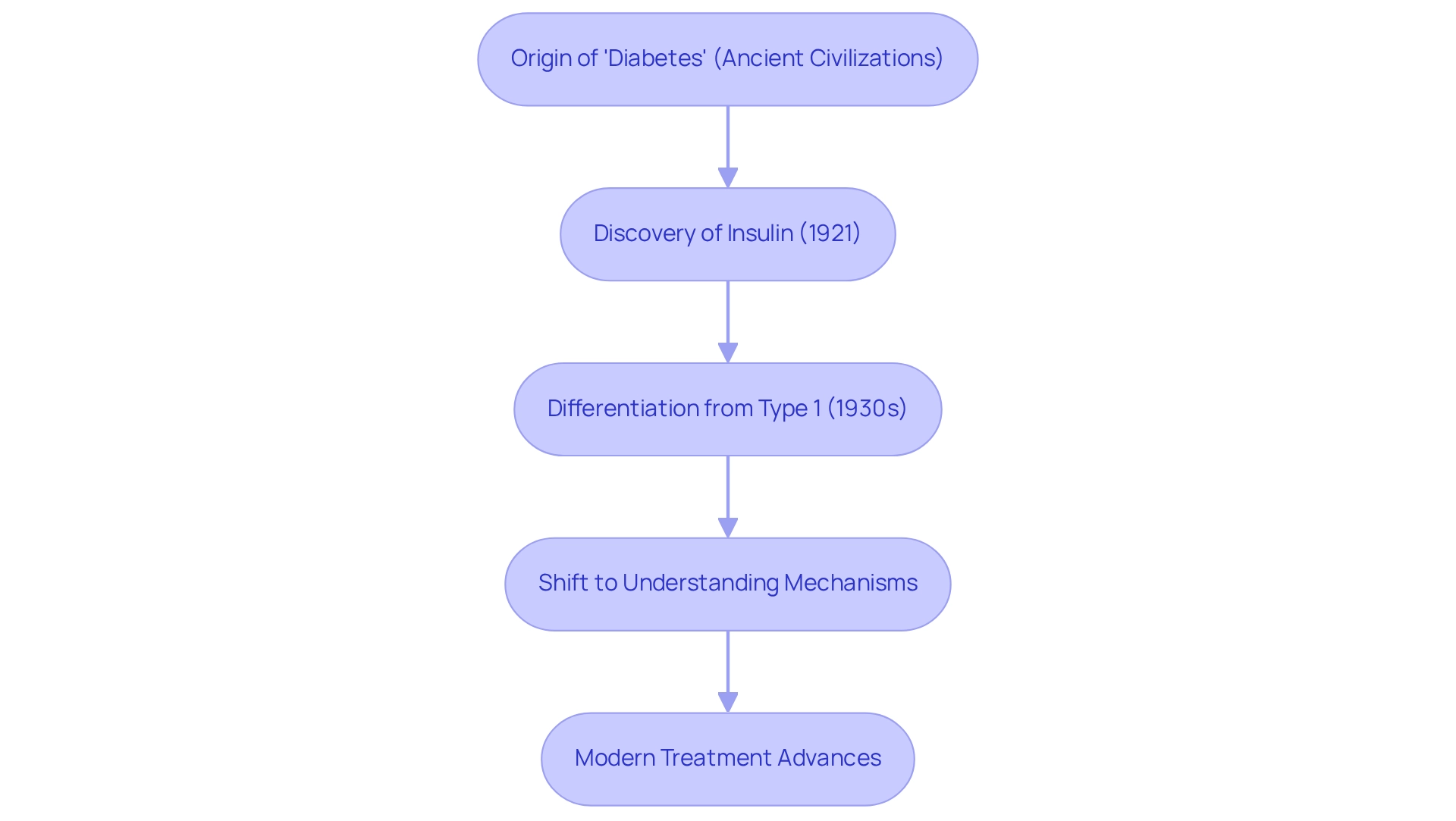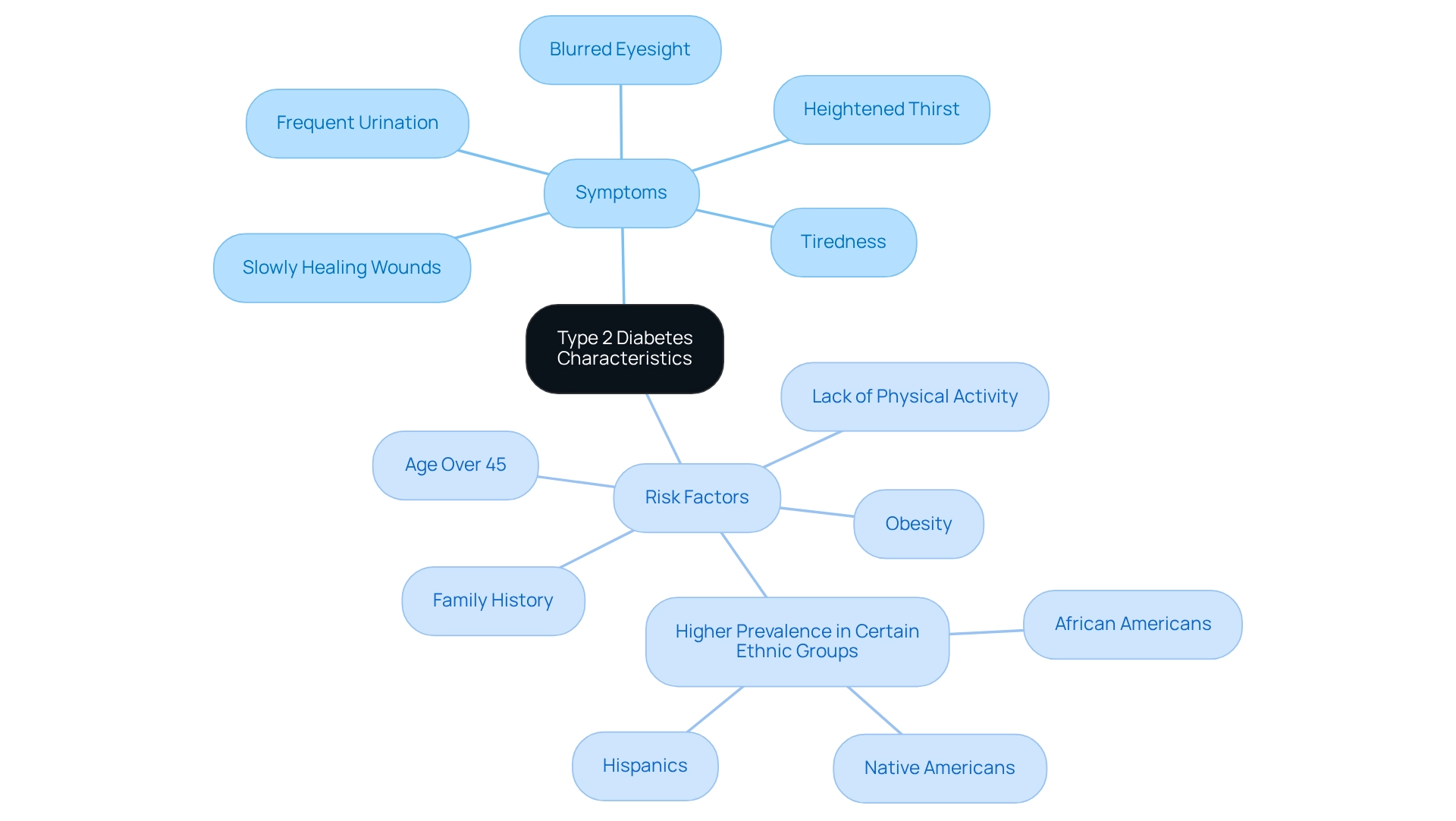Overview
Type 2 diabetes is a chronic metabolic disorder that can feel daunting, characterized by elevated blood sugar levels due to insulin resistance and insufficient insulin production. Often linked to obesity and sedentary lifestyles, this condition is becoming increasingly prevalent worldwide. It's understandable to feel concerned as you learn more about this diagnosis.
The importance of lifestyle modifications and public health initiatives cannot be overstated. These efforts are vital for effective management and prevention of Type 2 diabetes. Rising statistics highlight the urgent need for community support, reminding us that we are not alone in this journey.
If you or someone you know is facing this challenge, remember that there are resources available to help. Lifestyle changes can make a significant difference, and seeking support from healthcare professionals can provide guidance tailored to your needs. Together, we can navigate this path toward better health and well-being.
Introduction
Type 2 Diabetes has emerged as a pressing global health crisis, affecting millions and reshaping how we think about chronic disease management. This intricate condition, rooted in insulin resistance and often linked to lifestyle choices, presents a multifaceted challenge that goes beyond just physical symptoms. With alarming statistics showing a sharp rise in prevalence—especially among vulnerable populations—the urgency for effective prevention and management strategies has never been greater.
It's understandable to feel overwhelmed by the complexities of this disease. From the historical evolution of our understanding of diabetes to the critical role of lifestyle interventions and community support, the journey toward managing Type 2 Diabetes is both complex and essential. As new resources like T2DSolutions strive to empower individuals through education and support, understanding the nuances of this disease becomes crucial for fostering healthier communities. Remember, you're not alone in this journey; we are here to support you every step of the way.
Define Type 2 Diabetes: Understanding Its Core Meaning
What is type 2 diabetes mean is a long-lasting metabolic issue characterized by increased blood sugar levels due to insulin resistance and a relative lack of insulin. Unlike form 1 of the condition, where the pancreas does not generate insulin, individuals with form 2 of the ailment can produce insulin, but their bodies do not use it efficiently. This condition usually emerges slowly and is strongly associated with elements like obesity, inactive habits, and genetic tendency.
Recent research shows that the occurrence of this condition has been escalating notably, with a yearly rise of 4.8% documented from 2002 to 2012. In South Africa, the burden of diabetes was quantified at 1374 Disability-Adjusted Life Years (DALYs) per 100,000 in 2017, underscoring the urgent need for effective management strategies. This statistic emphasizes the essential significance of tackling lifestyle elements through public wellness programs aimed at nutrition and exercise to fight this escalating epidemic, and understanding what is type 2 diabetes mean is vital as it highlights the complex nature of the illness that affects not only physical wellness but also lifestyle and emotional well-being. Insulin resistance, a core characteristic of this disorder, can lead to various complications if not managed properly.
For example, lifestyle elements like poor diets and insufficient physical activity have been recognized as major factors in the increasing occurrence of this chronic condition. Tackling these elements through public health programs is crucial for prevention and management, as highlighted in studies that recognize these lifestyle modifications as critical. Additionally, recent studies emphasize the efficacy of interventions such as metformin, which has demonstrated a 31% reduction in the likelihood of developing the condition in younger and heavier prediabetic adults. However, ongoing monitoring and consultation with healthcare providers are vital to ensure safe usage. This corresponds with the necessity for cooperative care among healthcare professionals, which is crucial for efficient education and patient support.
As T2DSolutions launches as a new resource hub for conditions related to Type 2, it aims to provide valuable resources, including instructional materials and community involvement opportunities, to recently diagnosed patients. This holistic approach to management encompasses lifestyle changes, emotional support, and community involvement, which are critical for effective diabetes management. As mentioned by the CDC, the rise in sugar-related illness across all ethnicities during puberty further highlights the necessity for focused interventions and assistance for younger demographics.

Contextualize Type 2 Diabetes: Importance and Prevalence
Chronic illness, particularly diabetes, is a common condition affecting approximately 537 million adults worldwide as of 2021. Alarmingly, forecasts suggest that this figure may rise to 783 million by 2045. This trend is driven by increasing obesity rates, sedentary lifestyles, and an aging population. It's important to recognize that this condition is linked to severe medical complications, including cardiovascular disease, kidney failure, and neuropathy, highlighting its status as a critical public welfare concern.
In regions like Central Latin America, the increase in class 2 diabetes occurrences is especially striking, with diabetes-related wellness burdens skyrocketing by 222.5%. This significant rise underscores the urgent need for enhanced healthcare access and effective management strategies. For instance, in Saudi Arabia, the Disability-Adjusted Life Years (DALY) count reached 391,000, reflecting the substantial impact of diabetes on quality of life.
As we look ahead to 2025, the incidence of condition 2 continues to rise, prompting health organizations to stress the importance of proactive prevention and management efforts. Experts suggest that the increasing rates of adult-onset diabetes and obesity are interconnected, necessitating a comprehensive strategy to address this escalating epidemic. It's understandable to feel overwhelmed by these statistics, but remember, 'the call for practical action to change healthcare for those with diabetes is essential, particularly for marginalized groups who are disproportionately impacted.' Grasping these dynamics is vital for recognizing what type 2 diabetes means and the significance of thorough prevention and management initiatives in the fight against this condition. At T2DSolutions, we are here to support you every step of the way, offering valuable resources and assistance to tackle these challenges. Together, we can nurture a community centered on effective management and education related to health conditions. You're not alone in this journey; we are committed to helping you navigate the complexities of diabetes.

Trace the Origins of Type 2 Diabetes: Historical Development
The history of the second form of the condition can be traced back to ancient civilizations. The term 'diabetes' originates from the Greek word 'siphon,' aptly describing the frequent urination characteristic of the illness. Notable progress in understanding blood sugar regulation emerged in the early 20th century, especially after the revolutionary discovery of insulin in 1921. This crucial moment transformed treatment choices, enabling improved management of symptoms related to the condition, and it's important to recognize what type 2 diabetes mean, which wasn't clearly acknowledged as distinct from Type 1 until the 1930s. This differentiation marked a significant turning point in research, leading to a deeper exploration of what is type 2 diabetes mean and its underlying mechanisms. Over the decades, the focus has shifted from merely addressing symptoms to thoroughly understanding what is type 2 diabetes mean, which has enabled the advancement of various treatment methods.
For instance, lifestyle modifications, such as dietary changes and exercise, have become essential elements in managing the illness. Furthermore, pharmacological treatments have progressed considerably. Contemporary agents like SGLT2 inhibitors and GLP1 agonists are showing encouraging results in weight loss and cardiovascular protection for individuals with diabetes, raising the question of what is type 2 diabetes mean, as noted by Mohsen Abbasi-Kangevari. Identifying the signs of diabetes—such as excessive thirst, frequent urination, blurred vision, fatigue, and unexplained weight loss—is vital for early diagnosis and intervention. Recognizing these symptoms can greatly enhance well-being outcomes.
In Tunisia, the age-standardized DALY rate was reported at 1111.2 per 100,000, while in Southern Latin America, the DALY count was 648, with a rate of 762.3 per 100,000. These statistics emphasize the ongoing prevalence of blood sugar disorders across different demographics, underscoring the pressing need for education and effective management strategies.
As T2DSolutions launches as a new resource hub for conditions related to blood sugar management and community support, understanding the historical context of such conditions is essential. This knowledge informs the resources and support that T2DSolutions aims to provide, empowering individuals to manage their condition effectively and improve their health outcomes. Remember, you're not alone in this journey—we are here to support you every step of the way.

Identify Key Characteristics: Symptoms and Risk Factors of Type 2 Diabetes
Common signs of what is type 2 diabetes mean include heightened thirst, frequent urination, tiredness, blurred eyesight, and slowly healing wounds. These symptoms often develop gradually, making it easy for individuals to overlook them until complications arise. It's concerning that many people remain undiagnosed, underscoring the necessity for awareness and early identification.
Risk factors for developing Type 2 Diabetes include:
- Obesity
- Lack of physical activity
- A family history of the illness
- Age over 45
It's important to note that certain ethnic groups, such as African Americans, Hispanics, and Native Americans, show a higher prevalence of these risk factors. For example, research indicates that African Americans are nearly twice as likely to develop Type 2 Diabetes compared to their white peers. The Centers for Disease Control and Prevention (CDC) highlights that Type 2 Diabetes is increasingly diagnosed around puberty across all ethnic groups, emphasizing the need for vigilance among younger populations.
Healthcare professionals stress the importance of recognizing these symptoms and risk factors for timely intervention and management. Regular monitoring of wellness indicators, like blood sugar levels, can lead to early detection and improved outcomes. As the prevention of health issues becomes more critical, the number of organizations offering related programs is on the rise, reflecting a growing commitment to addressing this public health challenge. These programs often include digital tools for monitoring and personalized wellness plans, which T2DSolutions aims to provide as part of its resource hub for newly diagnosed patients.
Furthermore, an astonishing $379.9 billion is allocated for care related to blood sugar disorders in the U.S., highlighting the importance of this issue and the need for awareness and early detection. By understanding what is type 2 diabetes mean, along with its common symptoms and risk factors, you can take proactive steps toward better health management. Remember, the risk factors mentioned are not exhaustive, and ongoing education from healthcare professionals can offer deeper insights into managing diabetes effectively. You're not alone in this journey; we are here to support you every step of the way.

Conclusion
Type 2 Diabetes is not just a medical condition; it represents a significant and growing public health challenge that affects millions around the world. Understanding its core definition reveals the complexities of this chronic condition, driven by insulin resistance and influenced by lifestyle factors such as obesity and inactivity. The alarming rise in prevalence, particularly among vulnerable populations, highlights the urgent need for effective management strategies and public health initiatives that prioritize education and lifestyle changes.
The historical context of Type 2 Diabetes reflects the evolution of our understanding and treatment of the disease. From its ancient origins to modern advancements in pharmacological therapies and lifestyle interventions, it is clear that a comprehensive approach to management is essential. Recognizing the symptoms and risk factors associated with Type 2 Diabetes is critical for early detection and intervention, which can significantly improve health outcomes.
As resources like T2DSolutions emerge to support individuals on their journey, it becomes imperative to foster community engagement and empower those affected by Type 2 Diabetes. By prioritizing education, awareness, and proactive management, individuals can take charge of their health and contribute to the broader effort to combat this growing epidemic. Remember, you are not alone in this journey. Together, a collective commitment to understanding and addressing Type 2 Diabetes will pave the way for healthier communities and improved quality of life for those affected.
Frequently Asked Questions
What is type 2 diabetes?
Type 2 diabetes is a long-lasting metabolic issue characterized by increased blood sugar levels due to insulin resistance and a relative lack of insulin. Unlike type 1 diabetes, individuals with type 2 diabetes can produce insulin but their bodies do not use it efficiently.
What are the main causes of type 2 diabetes?
The main causes of type 2 diabetes include obesity, inactive habits, and genetic predisposition. Poor diets and insufficient physical activity are also recognized as major contributing factors.
How has the occurrence of type 2 diabetes changed over recent years?
Recent research indicates that the occurrence of type 2 diabetes has been escalating, with a documented yearly rise of 4.8% from 2002 to 2012.
What is the significance of the 1374 Disability-Adjusted Life Years (DALYs) statistic in South Africa?
The statistic of 1374 DALYs per 100,000 in South Africa in 2017 underscores the urgent need for effective management strategies for diabetes, emphasizing the importance of addressing lifestyle factors through public health programs.
What role do lifestyle modifications play in managing type 2 diabetes?
Lifestyle modifications, including improved nutrition and increased physical activity, are critical for the prevention and management of type 2 diabetes, as highlighted in various studies.
What interventions have shown effectiveness in reducing the likelihood of developing type 2 diabetes?
Interventions such as metformin have demonstrated a 31% reduction in the likelihood of developing type 2 diabetes in younger and heavier prediabetic adults.
Why is ongoing monitoring and consultation with healthcare providers important?
Ongoing monitoring and consultation with healthcare providers are vital to ensure the safe usage of treatments and to facilitate cooperative care among healthcare professionals for effective education and patient support.
What is T2DSolutions and what does it offer?
T2DSolutions is a new resource hub for conditions related to type 2 diabetes, aiming to provide valuable resources such as instructional materials and community involvement opportunities for recently diagnosed patients.
Why are focused interventions necessary for younger demographics regarding type 2 diabetes?
Focused interventions are necessary for younger demographics due to the rise in sugar-related illnesses across all ethnicities during puberty, highlighting the need for targeted assistance and support.



